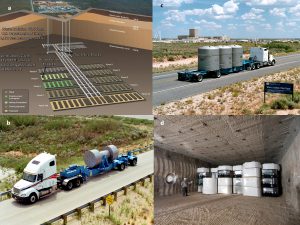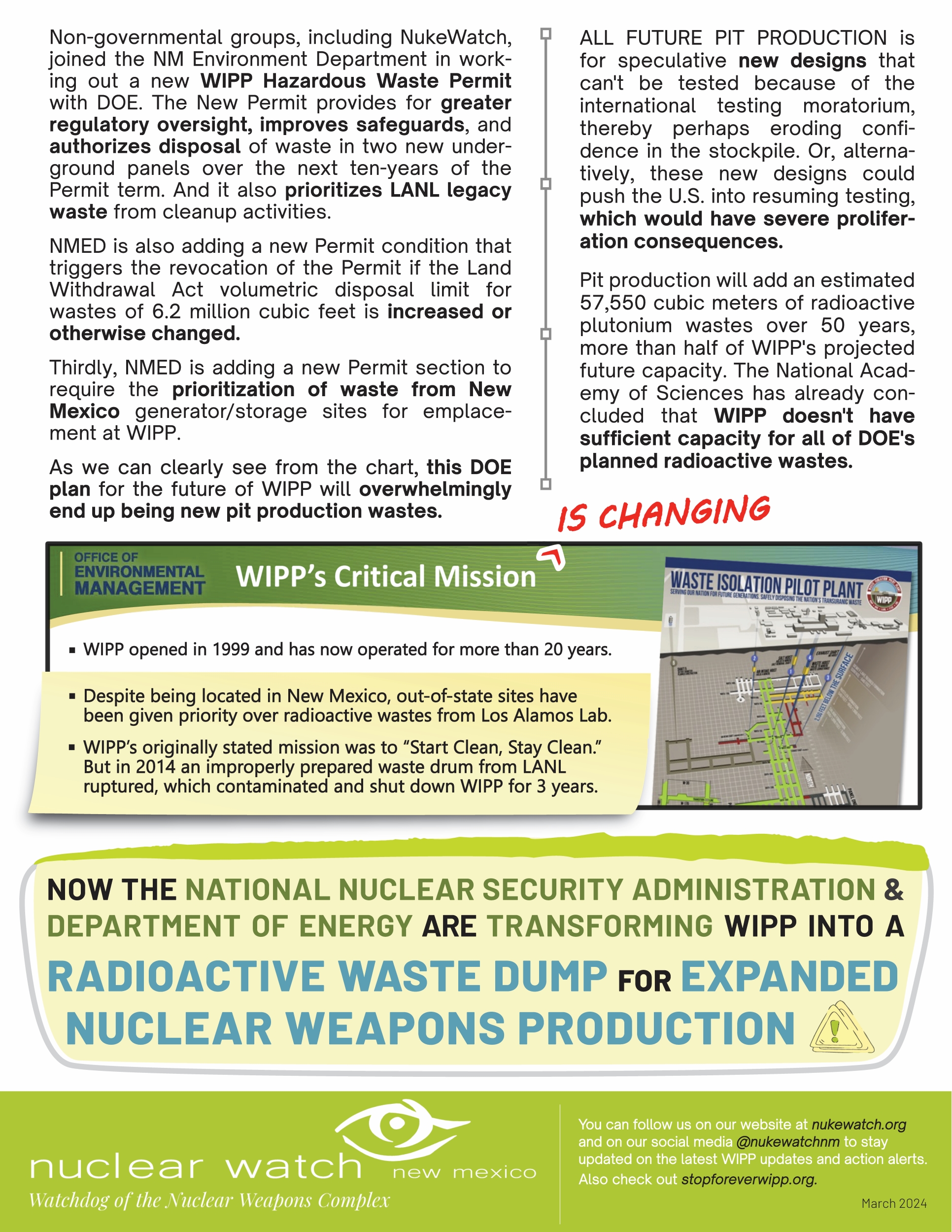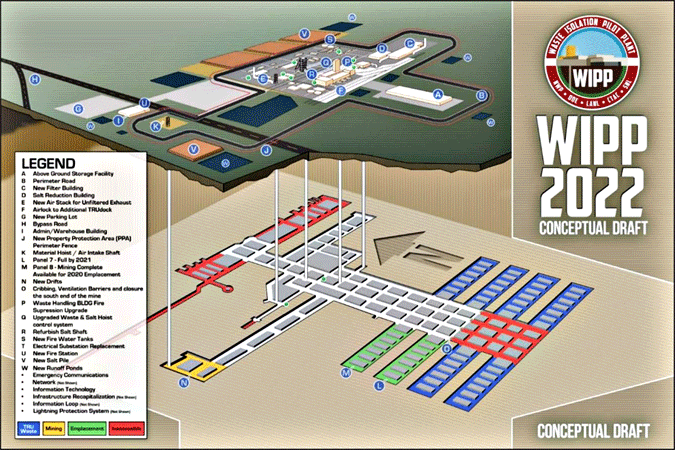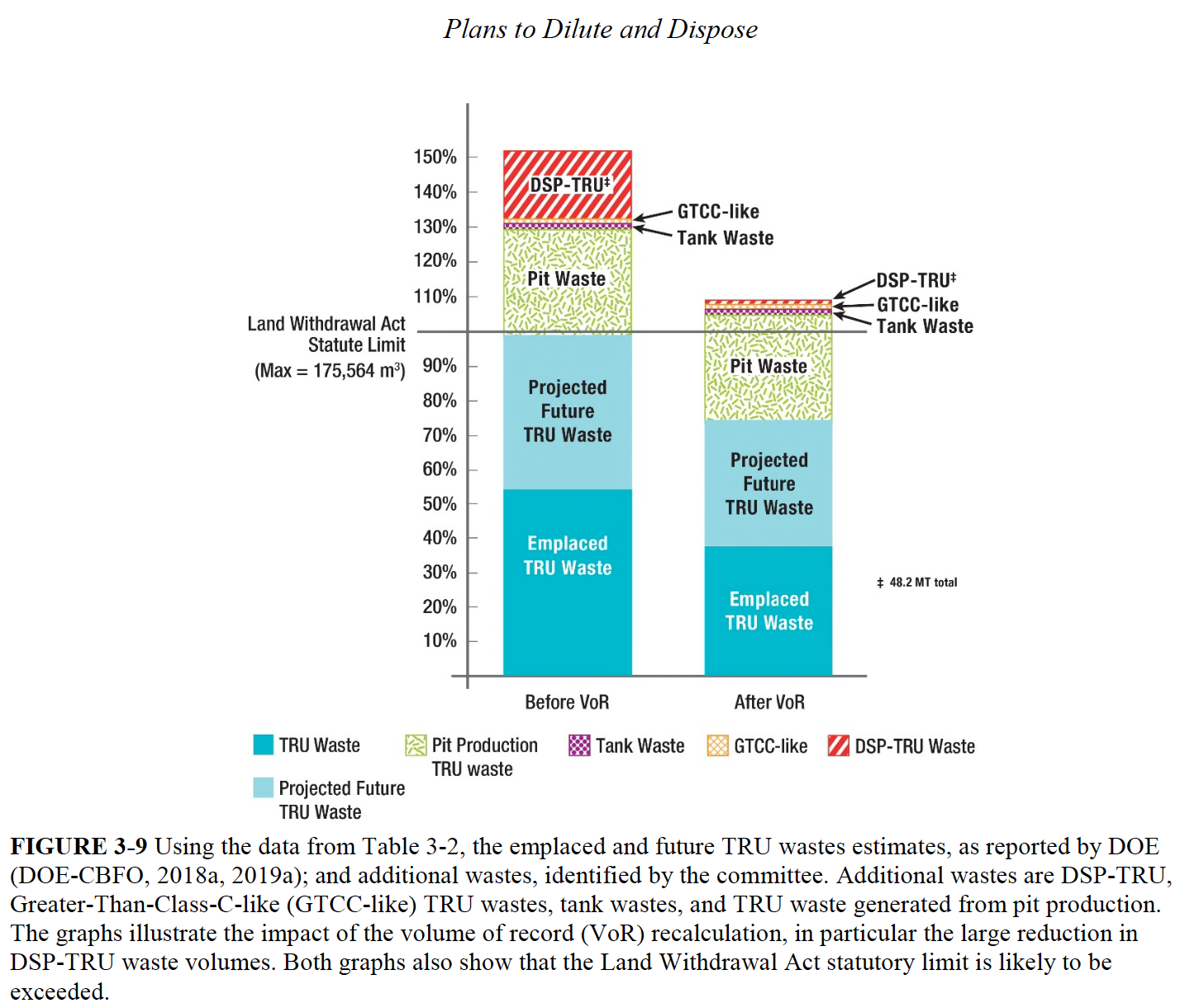Description and Current Mission
The Waste Isolation Pilot Plant (WIPP) is the nation's only deep geologic long-lived radioactive waste repository. Located 26 miles southeast of Carlsbad, New Mexico, the WIPP repository is mined within a 2,000-foot-thick bedded-salt formation. The Underground (U/G) is 2,150 feet beneath the ground surface. WIPP was constructed to determine the efficacy of an U/G repository for disposal of transuranic (TRU) waste. Disposal operations began in 1999 and are scheduled to continue for 35 years. WIPP was constructed for disposal of defense-generated TRU waste from DOE sites around the country. TRU waste consists of clothing, tools, rags, residues, debris, soil and other items contaminated with small amounts of plutonium and other man-made radioactive elements. The waste is permanently disposed of in rooms mined in an underground salt bed layer over 2000 feet from the surface.
TRU waste began accumulating in the 1940s with the beginning of the nation's nuclear defense program. As early as the 1950s, the National Academy of Sciences recommended deep disposal of long-lived TRU radioactive wastes in geologically stable formations, such as deep salt beds.
TRU waste is categorized as "contact-handled" or "remote-handled" based on the amount of radiation dose measured at the surface of the waste container. Contact-handled waste has a radiation dose rate not greater than 200 millirem (mrem) per hour, while remote-handled waste can have a dose rate up to 1,000 rem per hour. About 96 percent of the waste to be disposed at WIPP is contact-handled.
TRU waste is long-lived and has to be isolated to protect public health and the environment.
Four shafts connect the U/G area with the surface. The Waste Shaft headframe and hoist are located within the Waste Handling Building and are used to transport TRU mixed waste, equipment, and materials to the repository. The Waste Hoist can also be used to transport personnel and materials. The Air Intake Shaft (AIS) and the Salt Handling Shaft provide ventilation to all areas of the U/G except for the Waste Shaft station. This area is ventilated by the Waste Shaft itself. The Salt Handling Shaft is also used to hoist mined salt to the surface and serves as the principal personnel transport shaft. The Exhaust Shaft serves as a common exhaust air duct for all areas of the U/G.
History of WIPP
Throughout the 1960s, government scientists searched for an appropriate site for radioactive waste disposal, eventually testing a remote desert area of southeastern New Mexico where, 250 million years earlier, evaporation cycles of the ancient Permian Sea had left a 2,000-foot-thick salt bed.
DOE was authorized by Public Law 96-164, Department of Energy National Nuclear Security and Military Applications of Nuclear Energy Authorization Act of 1980, to provide a research and development facility for demonstrating the safe, permanent disposal of TRU wastes from national defense activities and programs of the United States exempted from regulations by the U.S. Nuclear Regulatory Commission.
Congress limited WIPP to the disposal of defense-generated TRU wastes in the 1992 Land Withdrawal Act. In 1998, the U.S. Environmental Protection Agency certified WIPP for safe, long-term disposal of TRU wastes.
On March 26, 1999, the first waste shipment arrived at WIPP from Los Alamos National Laboratory in New Mexico.
The WIPP Land Withdrawal Act, Public Law 102-579, as amended by Public Law 104-201, authorized the disposal of 6.2 million cubic feet of defense TRU waste at the WIPP facility.
The WIPP facility operates in several regulatory regimes. DOE has authority over the general operation of the facility, including radiological operations prior to closure. The U.S. Environmental Protection Agency (EPA), through 40 Code of Federal Regulations (CFR) Parts 191 and 194, certifies the long-term radiological performance of the repository over a 10,000-year compliance period after closure of the facility. The State of New Mexico, through EPA delegation of the Resource Conservation and Recovery Act (RCRA), has issued a Hazardous Waste Facility Permit for the disposal of the hazardous waste component of the TRU waste. Additionally, the Mine Safety and Health Administration (MSHA) is required to perform four inspections per year of WIPP.
WIPP's disposal rooms are nearly a half mile below the surface (2,150 feet). By comparison, the Empire State Building is only 1,454 feet high.
Browse this page to keep updated on NukeWatch and other local community group's efforts to STOP FOREVER WIPP
STAY INFORMED:
Endless Nuclear Waste Storage in NM?? Not On Our Watch…
Keep up with the Stop Forever WIPP Coalition to learn how to take action against the Federal Government’s Plan to Expand WIPP and keep it open indefinitely.
Visit the Stop Forever WIPP Coalition’s website and social media:
Website: www.StopForeverWIPP.org
Facebook: facebook.com/StopfvrWIPP
Twitter: twitter.com/stopforeverwipp
Instagram: instagram.com/stopfvrwipp
Stay Informed of All Permit-Related Happenings at WIPP! Sign Up for Updates:
The New Mexico Environment Department maintains a Facility Mailing List to which you can add your name and address to get the latest information – just email Ricardo Maestas at the New Mexico Environment Department at ricardo.maestas@state.nm.us and ask to be added to the list. Or mail your request with your mailing address to:
Continue reading→
WIPP News & Updates
New Mexico Environment Department Surrendered to DOE Extortion
Santa Fe, NM.
The New Mexico State Auditor Office recently questioned whether two settlements between the New Mexico Environment Department and the Department of Energy were in the best interests of New Mexico. That Office noted:
“The New Mexico Environment Department unnecessarily forgave tens of millions of dollars in civil penalties related to various waste management issues and missed cleanup deadlines by the Department of Energy (DOE) and its contractors. Considering the seriousness of the violations, and the clarity regarding responsibility for the violations, it appears highly unusual that the Department would not collect any civil penalties under these circumstances.”
NMED completed an assessment of $54 million in penalties that would have gone to New Mexico, but did not enforce them before making the settlements with DOE. This was at a time when the state was beginning to face a serious budget crisis. As State Senator John Arthur Smith (Chair of the Senate Finance Committee) put it, NMED’s failure to levy penalties when New Mexico was facing a budget crisis is “taking it out of the pockets of our kids and young people when they do something like that.”
Jay Coghlan, Director of Nuclear Watch New Mexico, commented, “This is inexcusable that NMED preemptively surrendered to Department of Energy extortion. In effect DOE is saying if you, the regulator, fine us, we will cut the money the taxpayer has paid to clean up our mess that threatens the citizens you are suppose to protect.”
U.S. DOE Documents Obtained via FOIA Request Confirm “Mission Need” to Expand “Dilute and Dispose” Method of Plutonium Disposition at Savannah River Site, Replacing MOX
The “dilute and dispose” process would package and dispose of the plutonium as waste rather than processing it for use as nuclear reactor fuel. The disposal processes consists of mixing plutonium oxide with “stardust,” a secret inert material, into small containers that are then placed in drums for geologic disposal.
US Energy Secretary Rick Perry visits WIPP
“Perry said he is convinced WIPP is a safe solution for the nation’s nuclear waste, suggesting there are no plans to cut funding….” from KRQE.
WIPP, LANL Settlement Projects In Progress
“With nuclear waste again on the road to Carlsbad’s Waste Isolation Pilot Plant, work is underway to improve WIPP transportation routes around the state….” From Carlsbad Current Argus.
WIPP Seals Off Nuclear Waste For 10,000 Years. Should It Be A Model For Storage?
“Shut down after two 2014 incidents, New Mexico’s Waste Isolation Pilot Plant accepted its first new shipments of nuclear waste last week ….” From The Christian Science Monitor.
WIPP plans will go on even if Russia quits plutonium deal
The Albuquerque Journal reports:
“At Los Alamos and Sandia National Laboratories, the breakdown in the bilateral agreement may deal a decisive blow to already deteriorated relationships between scientists at New Mexico’s national laboratories and their Russian counterparts, who had been working together to iron out the technical aspects of plutonium disposition under the deal, according to Don Hancock with the Southwest Research and Information Center in Albuquerque.”
Ed Lyman of Union of Concerned Scientists said “Even until last week, the U.S. was optimistic that this was one area that Russia and the U.S. could cooperate.”
Russia Has Pulled Out Of The Troubled MOX Project
Russia has given many expliantions for their recent exit from the MOX pact. Overall it is clear that MOX is a “good idea gone bad”. For more see the links below.
Citing “the threat to strategic stability posed by US hostile actions against Russia”. ref
Russia’s Lavrov: Russia’s MOX pact exit is a signal to Washington that: “speaking in the language of sanctions & ultimatums won’t work”
The Russian Non-Proliferation Department’s official reason: The US did not officially inform on planned change of PU disposal method (from MOX plant to WIPP disposal) as required in 2000 pact.
More WIPP Fallout: NNSA Cuts Los Alamos Lab’s Award Fees by 90% Watchdogs Say Management Contract Should Be Put Out for Bid
Santa Fe, NM
Today, Los Alamos Lab Director Charles McMillan notified LANL employees that the National Nuclear Security Administration (NNSA) had slashed FY 2014 management award fees to $6.25 million. Seventeen million dollars were available in fixed fees, and around $40 million in incentive fees, resulting in a 90% cut to potential awards. In addition, NNSA declined to grant a previously pro forma one-year contract extension and most remarkably rescinded a contract extension from an earlier year (see more below). As justification, the agency invoked a “First Degree” performance failure… [that] created damage to DOE property or costs for cleaning, decontaminating, renovating, replacing or rehabilitating property that in aggregate exceed $2.5 million.”
This is more fallout from WIPP. The Los Alamos National Laboratory (LANL) used unapproved radioactive waste treatment procedures that resulted in a ruptured drum at the Waste Isolation Pilot Plant, contaminating 21 workers and indefinitely closing that multi-billion dollar facility. It will cost an estimated half-billion dollars to reopen WIPP, which will likely double. Additionally, the New Mexico Environment Department has proposed $54 million in fines against LANL and WIPP, and Congress has cut $40 million from cleanup programs at the Lab while adding $100 million to help reopen WIPP.
Watchdog Urges Increasing DOE Accountability in Wake of Fines
Santa Fe, NM
Today the New Mexico Environment Department (NMED) declared multiple violations at both the Waste Isolation Pilot Plant (WIPP) and Los Alamos National Laboratory (LANL). NMED plans to fine WIPP $17.7 million and LANL $36.6 million due to major procedural problems related to the handling of radioactive transuranic (TRU) wastes that contributed to two significant incidents at WIPP earlier this year.
In addition to “failure to adequately characterize waste” and other violations, LANL was cited for the processing of nitrate-bearing wastes and adding neutralizing agents to that waste stream. LANL treated this procedure as if it was outside the state hazardous waste permit, but NMED determined that these operations were not exempt. LANL treated 100s of waste drums without a permit, and one of these was apparently the cause of the February 14, 2014, radioactive release at WIPP that contaminated 21 workers.
Missed WIPP Deadline May Put Real Cleanup at LANL Back On Track
Santa Fe, NM
Today the New Mexico Environment Department (NMED) denied extension requests by Los Alamos National Laboratory (LANL) to delay cleanup milestones under a legally enforceable 2005 Consent Order. These denials by NMED counter a trend since January 2012 when NMED and LANL entered into a nonbinding “Framework Agreement” to ship 3706 cubic meters of above-ground transuranic waste from the Lab to the Waste Isolation Pilot Plant (WIPP) for permanent disposal. LANL radioactive wastes are now the main suspect in the February 14 contamination and subsequent shutdown of the multi-billion dollar WIPP.
NMED denied 14 extensions, now available in LANL’s Electronic Public Reading Room. These denials include construction of monitoring wells and investigation reports for cleanup of contaminated areas. All of them included language that LANL requested an extension based on the Lab’s need to divert resources to remove transuranic waste in accordance with the Framework Agreement. The denials repeatedly state, “Based on the Permittees’ [LANL’s] statement that they will not be able to meet the deadlines that they committed to in the Framework Agreement [to ship TRU wastes to WIPP], the request is hereby denied.”
STOP FOREVER WIPP! Specific News to WIPP Closing Plans
Nothing Found
It seems we can’t find what you’re looking for. Perhaps searching can help.
Video Presentation on WIPP Expansion - February 5, 2022
Resources & Media
Nothing Found
It seems we can’t find what you’re looking for. Perhaps searching can help.
National Academy of Scientists Report
Review of the Department of Energy's Plans for Disposal of Surplus Plutonium in the Waste Isolation Pilot Plant 2020
Action Alerts
Nothing Found
It seems we can’t find what you’re looking for. Perhaps searching can help.
Quotes
Nothing Found
It seems we can’t find what you’re looking for. Perhaps searching can help.





